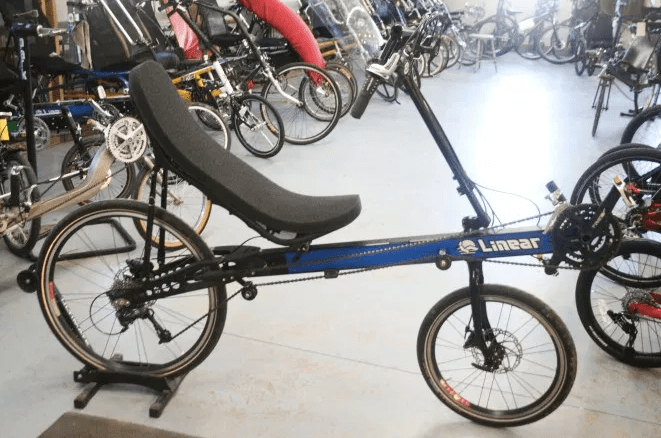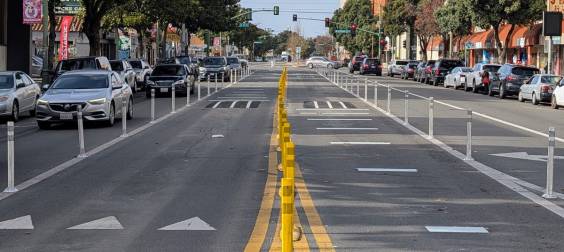“Disabled people don’t bike.”
“E-bikes aren't actually biking.”
Both statements are false, and both fallacies are linked.
As a cycling activist with a disability, I see the conversation surrounding e-bikes as another side of a larger issue. Because disabled people are often left out of the conversation, few abled cyclists seem to consider how non-traditional bikes can add to mobility for disabled people and provide many with a healthy mode of exercise and transportation.
According to a recent study by Wheels for Well-being, a British organization of disabled cyclists, 15 percent of people with disabilities cycle, compared with 18 percent of the general population. Moreover, two-thirds of cyclists with disabilities find cycling easier than walking, the group says.
Clearly, bikes are not just a mode of transit, but function as mobility devices for many disabled people. I find it ableist, or prejudiced against the disabled, when we consider e-bikes and other adaptive-cycling methods as “inferior.” Many of us can ride a traditional two-wheeled bicycle, but others simply can’t.
At bike-advocacy meetings, we talk about outreach: having more people at the table and more bike lanes, and fixing our streets. How can we make our cycling culture more accessible if we limit our advocacy to human-powered, two-wheeled cycles? In order to have better, larger cycling communities and stronger advocacy, we must consider disabled cyclists’ needs.
Some are the same needs as those of other cyclists: “Infrastructure causes the most difficulty for disabled cyclists,” according to the Wheels for Well-being study.
Think about the infrastructure that you ride daily. Could it accommodate other cycling methods? Would you feel comfortable riding recumbent in those bike lanes? If not, then reach out to your friends who do ride recumbent or who use adaptive bicycles, and see what they need to make them safer. Let your disabled friends lead the fight. Disabled cyclists are their own best advocates.
Other concerns are different. For example, an adaptive cycle is harder to store and lock. Conversations about bike storage must take into account that the standard city rack make it hard to lock adaptive cycles, creating further barriers for disabled cyclists. We should make sure that our street-storage facilities can accommodate recumbent bikes and hand cycles, so that disabled cyclists can use their bikes for transportation like everyone else.
Many might say that, if we don't have enough racks for two-wheeled cycles, how can we ask for racks that can accommodate adaptive cycles? To me, this smacks of ableism. Why should disabled cyclists come second? Can't they participate equally in the conversation?
The same can be said for e-bikes. We tend to view e-bikes either as being an elite mode of transit for people of means or as a tool for delivery workers. We forget that not everyone has the strength or, as many in the disability community might say, the “spoons,” to ride a two-wheeled cycle.
So how do we change our conversations and communities? First, educate yourself. Speak to, listen, and learn from cyclists with disabilities. Engage in the tough conversations about how our streets are inherently designed for the abled. Most important, if you are a leader, work to elevate the voices of those with disabilities, rather than speaking on their behalf.
Further, don’t be afraid to use the word “disability.” Disability is not a bad word but, too often, people feel uncomfortable using it. I’ve seen ads for rides that invite people to join and “ride to help support people with disABILITIES.” Using phrases like this glorifies the experience of living with a disability. Disabilities don’t give people superpowers, so stay away from phrases like “differently abled.”
Next, be accommodating. Invite people with disabilities to advocacy meetings and local rides. Accommodate people who are not riding a “traditional” two-wheeled cycle -- meaning hand cycles, recumbent cycles, e-bikes, and more. Further, make sure that meetings are held in accessible locations. A third-floor walkup with no elevator creates an inherently abled space. If your meeting isn't accessible for someone in a wheelchair, you are not creating an inclusive community.
In advocating for safer streets, don't tokenize your disabled friends. This is an easy trap, because many people like to refer to their friends of this or that minority group, in order to validate themselves and the causes that they support. The same is true for disabled cycling advocates. Don’t use a disabled community member as the sole example of disabled support of bike lanes. Rather, assemble a coalition of cyclists with intellectual and mobility impairments in order to broaden your advocacy.
Finally, don't try to speak on behalf of disabled people. By doing so, you engage in an ableist narrative that disabled people are weak and can’t speak for themselves. Most of us can hold our own and speak on our own behalf. After all, we’ve gotten pretty used to advocating for ourselves at medical appointments.
We live in a country that desperately needs safer streets. Abled people should be reaching out to the people for whom streets are most dangerous. It’s time that we break down these barriers, have these conversations, and include and embrace disabled people in our cycling communities. It’s also time that we listen and understand that sometimes we may have been wrong. In order to have more bike-able cities and livable streets, we must ensure that people with disabilities have a seat at the table.
Joelle Galatan is a cycling advocate in Queens.






